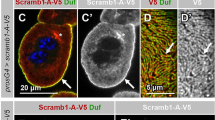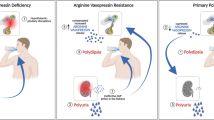Abstract
To elucidate the mechanism responsible for the establishment of steady state pH at zero net flux (pH∞) in proximal convoluted tubules, luminal pH was recorded continuously with antimony microelectrodes under three experimental conditions.
First: luminal pH in stationary droplets was allowed to reach pH∞ (6.76±0.07) and then carbonic anhydrase inhibitor benzolamide (3·10−3 mol/l) was superfused on the kidney surface. Following application of benzolamide, luminal pH decreased within seconds (ΔpH=−0.27±0.03 SEM).
Second: tubule segments were perfused continuously with MES-buffer containing solution set to a pH of 6.1. Some 1–2 mm distal to the perfusion pipette luminal pH was recorded and was 6.5±0.04. After superfusion of benzolamide (3·10−3 mol/l) pH decreased (ΔpH=−0.15±0.03).
Third: pH in stationary droplets was again allowed to reach pH∞ (6.69±0.01) and bicarbonate and CO2-free solution (5 mmol/l phosphate set to a pH of 7.4) was microinfused into the adjacent peritubular capillary. Luminal pH again decreased almost immediately (ΔpH=−0.23±0.02).
The data are interpreted as evidence for a bicarbonate leak. In a fourth series of experiments, segments of proximal tubules were perfused under benzolamide (0.4·10−6 mol/min) with solutions initially free of bicarbonate or other buffers. In the collected fluid, bicarbonate was determined by a micro-Astrup method. A significant increase of luminal bicarbonate concentration (r=0.88) indicates a permeability of 0.98±0.14·10−6 cm2/s of the tubular wall for bicarbonate. Since bicarbonate eventually increases more than 3-fold the equilibrium concentration, collected bicarbonate could not have been formed by H2CO3 or CO2.
Bicarbonate enters the luminal fluid and reacts with secreted hydrogen ions to form carbonic acid. It, therefore, buffers secreted hydrogen ions and increases luminal pH at or below steady state. Inhibition of carbonic anhydrase and lowering of peritubular bicarbonate thus lower pH∞.
Similar content being viewed by others
References
Bank N, Aynedjian HS (1967) A microperfusion study of bicarbonate accumulation in the proximal tubule of the rat kidney. J Clin Invest 46:95–102
Burg M, Green N (1977) Bicarbonate transport by isolated perfused rabbit proximal convoluted tubules. Am J Physiol 233:F314
Boulpaep EL, Seely F (1971) Electrophysiology of proximal and distal tubules in the autoperfused dog kidney. Am J Physiol 221:1084–1096
Cassola AC, Giebisch G, Malnic G (1977) Mechanisms and components of renal tubular acidification. J Physiol (Lond) 267:601–624
Cogan MG, Maddox DA, Warnock DG, Lin ET, Rector FC (1979) Effect of acetazolamide on bicarbonate reabsorption in the proximal tubule of the rat. Am J Physiol 237:F447-F454
Frömter E, Rumrich G, Ullrich KJ (1973) Phenomenologic description of Na+, Cl− and HCO −3 absorption from proximal tubules of the rat kidney. Pflügers Arch 43:189–220
Frömter E, Sato K, Gessner K (1976) Electrical studies on the mechanism of H+/HCO −3 -transport across rat kidney proximal tubule. Proc. 6th int Congr Nephrol, Florence 1975, 108–112. Karger, Basel
Giebisch G, Malnic G, De Mello GB, De Mello Aires M (1977) Kinetics of luminal acidification in cortical tubules of the rat kidney. J Physiol (Lond) 267:571–599
Green R, Giebisch G (1974) Some problems with the antimony microelectrode. In: Berman HJ, Hebert NSC (eds) Ion selective microelectrodes. Plenum Press, New York, pp 43–53
Karlmark B, Danielson BG (1974) Titratable acid, PCO2 bicarbonate and ammonium ions along the rat proximal tubule. Acta Physiol Scand 91:243–258
Knox FG, Haas JA, Lechene CP (1976) Effect of parathyroid hormone on phosphate reabsorption in the presence of acetazolamide. Kidney Int 10:216–220
Kunau RT (1972) The influence of the carbonic anhydrase inhibitor, benzolamide (CL-11.366), on the reabsorption of chloride, sodium and bicarbonate in the proximal tubule of the rat. J Clin Invest 51:294–306
Lang F, Greger R, Lechene C, Knox FG (1978) Micropuncture techniques. In: Martinez-Maldonado M (ed) Methods in pharmacology, Vol 4b, Chapter 4. Plenum Press, New York, pp 75–103
Lang F, Quehenberger P, Greger R, Oberleithner H (1978) Effect of benzolamide on luminal pH in proximal convoluted tubules of the rat kidney. Pflügers Arch 375:39–43
Lucci MS, Warnock DG, Rector FC (1979) Carbonic anhydrasedependent bicarbonate reabsorption in the rat proximal tubule. Am J Physiol 236:F58-F65
Malnic G, De Mello Aires M (1971) Kinetic study of bicarbonate reabsorption in proximal tubule of the rat. Am J Physiol 220:1759–1767
Malnic G, Vieira FL (1972) The antimony microelectrode in kidney micropuncture. Yale J Biol Med 45:356–367
Maren TH (1967) Carbonic anhydrase: Chemistry, physiology, and inhibition. Physiol Reviews 47:595–781
Maren TH (1974) Chemistry of the renal reabsorption of bicarbonate. Can J Physiol Pharmacol 52:1041–1050
Maren TH (1977) Use of inhibitors in physiological studies of carbonic anhydrase. Am J Physiol 232:F291-F297
McKinney TD, Burg MB (1977) Bicarbonate and fluid absorption by renal proximal straight tubules. Kidney Int 12:1–8
Puschett JB, Zurbach PE (1974) Re-evaluation of microelectrode methodology for the in vitro determination of pH and bicarbonate concentration. Kidney Int 6:81–91
Quehenberger P (1977) The influence of carbon dioxide, bicarbonate and other buffers on the potential of antimony microelectrodes. Pflügers Arch 368:141–147
Rector FC Jr, Carter NW, Seldin DW (1965) The mechanism of bicarbonate reabsorption in the proximal and distal tubules of the kidney. J Clin Invest 44:278–290
Silbernagl S, Lang F, Quehenberger P, Maren TH (1979) Kinetic parameters of HCO3-reabsorption in the proximal convoluted tubule. A microperfusion study in rat kidney. Upsala J Med Sci Suppl 26
Ullrich KJ, Frömter E, Murer H (1977) How is the proximal isotonic absorption inhibited by carbonic anhydrase inhibitors. In: Siegenthaler, Beckerhoff, Vetter (eds), Diuretics in research and clinics. Thieme, Stuttgart, pp 2–7
Ullrich KJ (1973) Permeability characteristics of the mammalian nephron. In: Orloff J, Berliner RW (eds) Handbook of physiology, Section 8: Renal physiology. American Physiological Society, Washington DC
Ullrich KJ, Rumrich G, Baumann K (1975) Renal proximal tubular buffer-(glycodiazine) transport. Inhomogeneity of local transport rate, dependence on sodium, effect of inhibitors and chronic adaptation. Pflügers Arch 357:149
Warnock DG, Rector FC (1977) CO2 permeability of the rabbit proximal straight tubule. Kidney Int 12:576
Wistrand PJ, Kinne R (1977) Carbonic anhydrase activity of isolated brush border and basal-lateral membranes of renal tubular cells. Pflügers Arch 370:121–126
Author information
Authors and Affiliations
Rights and permissions
About this article
Cite this article
Lang, F., Quehenberger, P., Greger, R. et al. Evidence for a bicarbonate leak in the proximal tubule of the rat kidney. Pflugers Arch. 386, 239–244 (1980). https://doi.org/10.1007/BF00587474
Received:
Accepted:
Issue Date:
DOI: https://doi.org/10.1007/BF00587474




